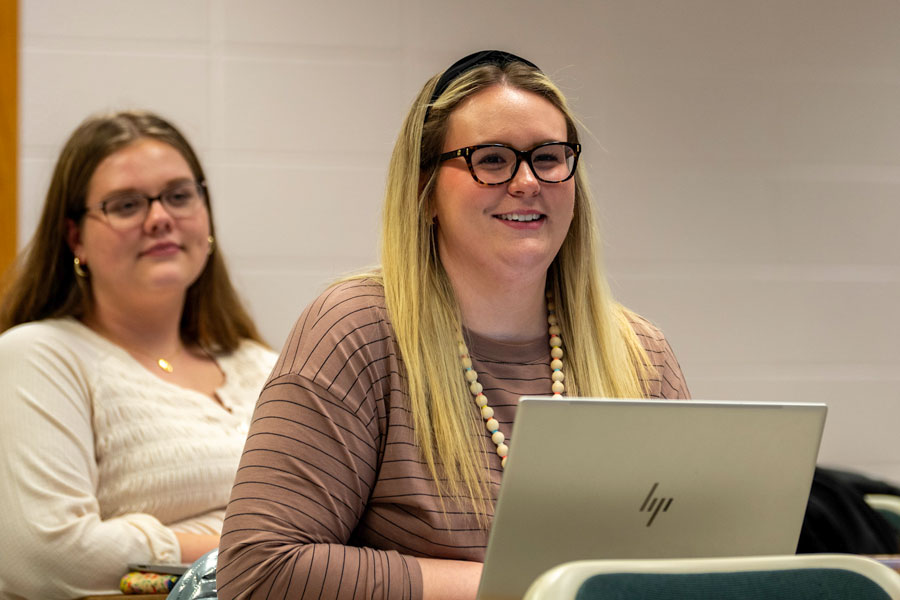
Joshua Schuessler of Rixford had already earned 15 college credits – equal to a typical semester – before ever stepping onto the University of Pittsburgh at Bradford’s campus as a first-year student.
Schuessler earned those credits while at Otto-Eldred High School through Pitt-Bradford’s College in the High School program, which allows students to earn college credits from certain courses taught by their high school teachers who are certified through the program.
He completed five courses, including algebra, biology and environmental studies, which all counted toward his general education requirement at Pitt-Bradford.
With that academic jump start, Schuessler, an early level education major, will graduate early and save some money.
“I highly recommend (the program) to high school students,” he said.
College in the High School is one of two programs at Pitt-Bradford in which high school students can earn college credits. The other is Bridges, where students come to campus to take courses. Typically, about 30 local students take part in Bridges each semester.
High school students taking college courses for credit – often called dual-enrollment programs – began in 1955 in the United States. Since then, participation has skyrocketed. Today, 82% of public high schools offer some kind of dual-enrollment program, according to the Center for Law and School Policy.
Like the national trend, Pitt-Bradford’s College in the High School program, now in its 20th year, also has grown significantly and has become one of the largest in Pennsylvania. In the program’s first year in 2005, 32 students from five high schools participated. This year, 1,216 students from 30 high schools are taking a total of 2,217 classes, which equals 7,251 college credits.
Schuessler is just one of several Pitt-Bradford students who is reaping the benefits of the program.
Sarie Yohe of Bradford, an early level education major who expects to graduate this spring, arrived on campus with nine credits, which helped her maintain a manageable credit load throughout her time at Pitt-Bradford.
“Not only did this help lessen my workload, but it was a cheaper route for my parents and I.”
Madison Hartman of Limestone, N.Y., a sophomore double major in applied mathematics and mathematics education, earned 20 college credits while a student at Bradford Area High School.
It helped save me a lot of money, and to double major and still graduate in time.
Students participating in the program pay $125 per class, not credit, already a substantial savings. However, some participating school districts also cover either all or part of that cost for their students.
Besides saving time and money, those who participated in CHS typically have done better as students at Pitt-Bradford.
“These students tend to have higher retention and graduation rates than those who don’t participate in the program,” said Dr. James Baldwin, vice president of enrollment management who co-directs the program with Dr. Steve Robar, associate professor of political science.
Educators from participating high schools recognize the value their students receive from the program.
“Otto-Eldred’s involvement … has been a game-changer for students,” said Matt Splain, superintendent of the Otto-Eldred School District where 54 students are currently taking part.
“Many students … gained a significant head start in their pursuit of a bachelor’s degree. Each of these students avoided thousands of dollars of debt … A number of students were able to graduate with a bachelor’s degree in less than four years …”
At St. Marys Area High School, where 74 students are participating, Spanish teacher Christa Wensel said, “The ability to receive college credits … relieves some of the stresses and pressures that they may face in the future. It’s a win-win.”
The program also gives students insight into the added rigor of college courses, which helps prepare them for college academics.
“The classes give students a taste of what college expectations will be like,” said Ray Doolittle, a guidance counselor at Brookville Junior-Senior High School who has seen first-hand the program’s benefits as the father of two sons who participated in the program. Currently 51 students in Brookville are participating in CHS.
“This is an opportunity that is well worth the time and investment,” Doolittle added.
At Kane Area High School, where 56 students are earning college credits, principal Todd Stanko said, “Having teachers from your hometown high school as instructors for these courses is a great transition experience for students planning to pursue post-secondary endeavors.”
George Riley, a guidance counselor who also teaches psychology at Port Allegany Junior-Senior High School, said, “This partnership with UPB is a great opportunity for our students.” Currently 36 Port Allegany students are part of the program.
For more information about College in the High School, contact Jody Randolph, program coordinator, at jar1@pitt.edu or visit www.upb.pitt.edu/community/college-high-school.